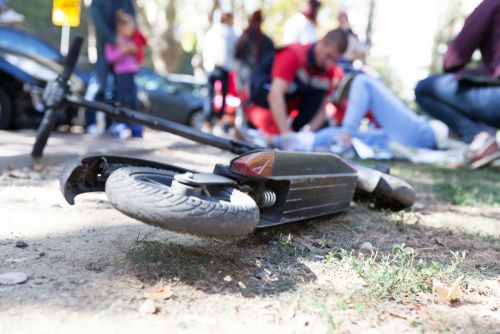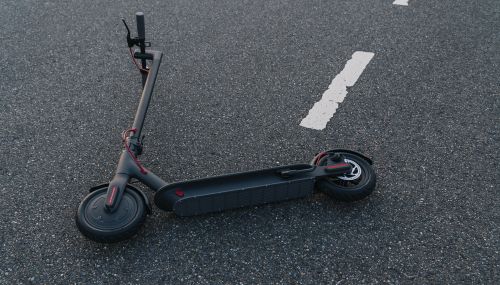Electric scooter accidents have become an increasing concern among city and state officials as well as the general public. Since 2017, this battery-operated vehicle has become a craze in dozens of cities across the United States. Electric scooters can be seen zooming through streets as well as on sidewalks. The rapid rise has been led by startup companies such as Lime and Bird, which were both established in 2017.
The popularity of e-scooters has been driven in part by very low rental fees, convenience, and the desire to use non-polluting transportation. Riders use a smartphone app to reserve and pay for a scooter rental. The scooters are dockless, which means that riders can conveniently drop off their scooters anywhere. Companies such as Lime and Bird use GPS to track, pick up, and recharge the scooters at the end of the day.
Along with convenience and the sudden popularity comes safety concerns, accidents, and lawsuits. Safety officials and medical facilities have struggled to keep up with the injuries and accidents associated with these scooters. Some of these concerns include:
- The majority of e-scooter riders do not wear helmets
- A large percentage of scooter-related injuries are head injuries, some of them severe
- There are gaps in data for injuries and helmet use, so the actual number of injuries from scooter crashes is not known
- There is no national data for electric scooter-related accidents
- Cities have been unprepared for the rapid rise in scooter ridership
- Road designs do not include lanes for battery-operated vehicles such as electric scooters
- Scooters can travel up to 20 miles per hour
- Riders do not always operate the scooters safely
- At least eight people have been killed in accidents involving electric scooters

Injury and Death Rates
E-scooter-related injuries were the subject of a 2018 study by the U.S. Centers for Disease Control (CDC) and the Departments of Health and Public Transportation in Austin. The study found that from September 2018 through November 2018, 20 people were injured for every 100,000 e-scooter rides. About half of those injuries were severe, such as bone fractures and organ damage. Although no deaths were recorded in the Austin study, Consumer Reports found that e-scooter crashes have resulted in at least 8 deaths since 2017.
Researchers at the Portland Bureau of Transportation found 2.2 accidents per 10,000 miles. This rate is much higher than the 0.1 percent for cars and the 0.05 percent for motorcycles. On the other hand, Bird’s Director of Safety Policy and Advocacy Paul Steely White states that cars are much more dangerous than e-scooters. He points out that in 2017, car accidents claimed 6,000 lives in the US.
Gaps in data make it difficult to get a clear picture of e-scooter injury and death rates. According to an Austin-based doctor, hospitals need to keep better data on injuries to e-scooter riders. For example, out of 60 hospitals surveyed nationwide, only 23 were able to provide data on injuries to electric scooter riders. The remaining hospitals did not or could not track injuries to riders.
Other injury statistics include:
- 360 scooter-related injuries at Grady Memorial Hospital in Atlanta, Georgia
- 250 injuries at Vanderbilt Hospital in Nashville, Tennessee
- 1500 people injured nationwide in e-scooter accidents since 2017
Head Injuries
Head injuries account for a large percentage of injuries to e-scooter riders and are among the most severe injuries reported. The Austin researchers found that nearly half of the 271 scooter-related injuries in the study were head injuries, and 15 percent were traumatic brain injuries.
Researchers at the University of California at Los Angeles found that from September 2017 to August 2018, 40 percent of 249 injuries to scooter riders were head injuries. 38 percent of the patients’ minor head injuries didn’t involve a skull fracture or bleeding inside the skull. Two percent had major head injuries that involved bleeding inside the skull.
Helmet Use
A major area of concern is the low rate of helmet use among e-scooter riders. The Austin study found that only one of the injured riders in the study had been wearing a helmet. The University of California San Diego Health Hospital reports helmet use in only 2 percent of 150 patients treated for scooter-related trauma.
Other research, however, has shown a higher rate of helmet use. Consumer Reports found that half of the riders surveyed stated that they wore a helmet while using an e-scooter. Helmet use may be increasing because more people are planning their rides ahead of time, rather than trying a scooter on the spur of the moment. Even with the higher rates of self-reported use, at least half of all e-scooter riders do not wear a helmet.
Since research shows that helmet use reduces head injuries among bicyclists, helmet use would likely reduce the risk of head injuries in scooter-related accidents. Although the websites of Lime and Bird recommend wearing helmets, Bird supported a California law that removed a helmet use requirement. Lime reports that it has given away 75,000 free helmets to promote safety.
Road Design and Traffic
Riders often don’t have much choice when it comes to a safe place to use their e-scooters. For example, California has banned e-scooters from public sidewalks due to safety concerns. Roadways, however, are often congested and lack designated lanes for bicycles and scooters.
Consumer Reports found that 51 percent of riders surveyed rode their scooters on sidewalks, and about 25 percent said that avoiding pedestrians was an issue on sidewalks. Only 26 percent used a bike lane, and 10 percent did not feel safe in traffic.
Accidents have resulted in legal action in some instances. In June, 2019, an injured rider filed a lawsuit against Bird, the city and county of Los Angeles, and the California Department of Transportation. The lawsuit claims that the design, construction, and maintenance of the intersection caused the collision between the rider and a car.
The Austin study found that more than half of scooter-related injuries took place in roadways, while one third occurred on sidewalks. Although cars were involved in 16 percent of injuries, only 10 percent of injuries involved a collision with a car. Most accidents took place during daylight hours, with 22 percent occurring during the morning and evening rush hour. Road conditions and objects, such as manhole covers, played a part in a small number of accidents.
Cities Are Unprepared for Electric Scooters
The popularity of e-scooters has caught many cities by surprise and left officials scrambling to develop regulations. In 2017, the scooters arrived, along with questions about helmet requirements and where scooters should be allowed. Since scooters can travel at speeds up to 15 to 20 miles per hour, riding a scooter on a sidewalk is an accident waiting to happen.
City officials found that scooters can create safety problems even when no one is riding them. For example, riders can leave the scooters anywhere for the next rider, so scooters that are left on sidewalks create a tripping hazard. Others are simply a nuisance because they are in the way.
As cities try to come up with solutions to scooter safety issues, some have taken drastic measures. Beverly Hills, California temporarily banned e-scooters, but an appeal by Bird is pending. Less severe measures that could reduce injuries include road widening and added lanes, as well as laws limiting the speed at which riders can use the scooters.

Scooter Conditions and Rider Actions
The condition of the e-scooter itself, as well as the actions of the riders, are factors in many accidents. Nineteen percent of the riders in the Austin study believed that a malfunctioning scooter was responsible for their accidents. Riders particularly cited problems with brakes or wheels.
Electric scooters have been the subject of some safety recalls. In 2018, Lime had to issue two recalls after the Washington Post reported injuries due to batteries catching fire and baseboards splitting while in use. Other riders have been thrown off their scooters while traveling at high speeds.
Some riders admitted behaviors that may have contributed to accidents. For example, one-third of riders reported to the Austin researchers that they had been drinking alcohol prior to their accidents. Distracted driving, such as talking on the phone or listening to music, played a role in a few accidents.
Careless actions by riders may contribute to pedestrian injuries. Pedestrians are injured when they are struck by a scooter on a sidewalk or when they trip over a scooter that was left on a sidewalk or other public place.
Rider age may be a factor in some injuries. Researchers at the Ronald Reagan UCLA Medical Center and the UCLA Medical Center in Santa Monica found that 11 percent of riders they had treated were under the age of 18. Scooter company regulations require riders to be at least 18 years old.
To make up for a lack of data, the UCLA researchers took the time to observe e-scooter riders in the streets. They found many safety violations among the 193 riders they observed, including:
- Children riding with their parents on one scooter
- People riding tandem on one scooter
- Excessive speed
- Riding on sidewalks
- More than 90 percent riding without a helmet
How Riders Can Prevent Injuries
Riders can take steps to ensure the safety of their scooters and prevent accidents. Scooter companies usually require renters to view a safety tutorial before they can unlock a scooter. Riders should pay close attention to these tutorials and take advantage of the safety instructions in the app.
A visual safety check is a must before every ride. Riders should make sure the brakes are in working order before starting out with their scooter. Malfunctioning or damaged equipment should always be reported to the company to avoid injuries to future riders. Companies should also provide an easy way for riders to report problems with the scooters.
Finally, every rider should operate their scooter at a safe speed and wear a helmet. If an accident occurs, a helmet can reduce the risk of serious head injuries.
New riders should take extra care to observe safety precautions. Researchers in the Austin study found that a third of the e-scooter riders surveyed had been injured during their first ride.
Need for Safety Awareness
As an environmentally friendly transportation alternative, electric scooters have taken the country by storm. The battery-operated vehicles may be controversial, but the numbers tell us that they will likely be around for a while. In 2018, people took 38.5 million rides on shared e-scooters. Ride-share car companies such as Uber and Lyft are looking into getting their piece of the e-scooter pie.
As popularity increases, cities, states and riders must make safety a priority. The story of 50-year-old Paul Grasso is an example of the risks associated with electric scooters. While walking to the store in San Diego, Grasso decided to try an electric scooter that had been dropped off by a previous rider. He installed the app on his phone and rented the scooter, which did not come with a helmet.
As he traveled at 15 miles-per-hour in the street, Grasso moved onto the sidewalk to avoid road construction. After hitting a bump, he crashed and was hospitalized with head injuries for four days.
The first scooter-related death in Austin, Texas occurred when Mark Sands was riding in the wrong direction on a city street. The 21-year-old exchange student suffered severe injuries and died at the hospital on the following day.
These accidents illustrate a wide range of scooter-related safety concerns:
- Did the rider have a helmet?
- Was a helmet included with the scooter rental?
- Was there a safe place or designated lane in the street for the scooter during road construction?
- Was the scooter traveling at a high speed on the sidewalk?
- Were roads clearly marked and did the rider follow traffic safety regulations?
Contact Us
There are many possible factors involved in a scooter accident, including road conditions, brake malfunctions and speed. Besides physical and emotional pain, accidents can result in high medical bills and lost time at work. A top-quality law firm will deal with all of these details so that the accident victim can focus on healing and quality of life.
Do you or a loved one need assistance after being injured in a scooter-related accident? Please feel free to contact us at Betta Fulkerson.




